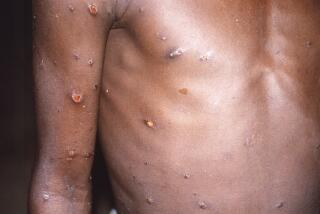HIV Rate Grows in Most of the World
Aggressive treatment and prevention programs have reduced HIV infection rates in Kenya, Zimbabwe and the Caribbean, but the numbers continue to grow in the rest of the world, with more than 40 million people now living with the virus, according to a United Nations report.
Globally, 4.9 million people became infected with HIV, the virus that causes AIDS, last year and 3.1 million died of the disease.
“It’s increasing everywhere,” Dr. Jim Yong Kim, director of HIV/AIDS for the World Health Organization, said in a news conference Monday. “The report illustrates very clearly that we really are failing in attempting to prevent the epidemic in the rest of the world.”
The epidemic is rapidly gaining steam in Eastern Europe and Asia, where injection drug use and unsafe sex are common.
As recently as five years ago, Asia accounted for one in 10 new infections, the report says. Today, at least one in five occur there. More than 1.1 million people in Asia became infected in 2004 and 520,000 died of AIDS, up from 420,000 fatalities the previous year.
“The reality is that the AIDS epidemic continues to outstrip global and national efforts to contain it,” said Dr. Peter Piot, executive director of UNAIDS, the U.N. program on AIDS.
Ignorance accounts for much of the spread, officials said. In India, more than 40% of prostitutes surveyed claimed they could tell whether a customer had HIV from his appearance.
In Karachi, Pakistan, 20% of prostitutes did not know what a condom was and one-third had never heard of AIDS. In the Philippines, 90% of people believed that HIV could be contracted by sharing a meal with an infected person.
Despite that gloomy news, WHO officials could point to some gains in the regions that have been hit the hardest.
Declines in the infection rate had previously been noted in Senegal, Uganda and Thailand, but those were considered anomalies.
“Now we have Kenya, several of the Caribbean countries and Zimbabwe with a decline,” Piot said at the telephone news conference where the report was released. “If you see a decrease in prevalence in young people, that reflects a decrease in prevalence in recent infections.”
In those countries, he added, “people are starting later with their first sexual intercourse. They are having fewer partners. There’s more condom use. It’s a consistency now that’s a really good sign.”
In the Caribbean, infection rates fell in Barbados, Bermuda and the Bahamas. Cities in Haiti also showed declines in the number of people living with HIV, but that may be partly the result of increased deaths from AIDS, Piot said.
In Kenya, the HIV infection rate among pregnant women dropped from 28% in 1999 to 9% in 2003, he said, while overall infection rates among adults dropped from 10% to 7%.
In Zimbabwe, the rate among pregnant women dropped from 35% to 21% in the same period.
“This year’s epidemic update shows that HIV prevention programs are working in pockets,” said Purnima Mane, UNAIDS director of policy, evidence and partnerships. “We need to make it work at the world level.”
The report notes that antiretroviral drugs commonly available to HIV victims in most developed countries are now reaching more than 1 million people in developing countries. The drugs prevented an estimated 300,000 deaths last year, the report says, but they are reaching only about 20% of those who desperately need them.
So far, about $8 billion has been spent on HIV/AIDS in developing countries this year, an increase of $1 billion from 2004. Piot said about $9 billion would be spent next year, but that at least $15 billion would be needed.
More to Read
Sign up for Essential California
The most important California stories and recommendations in your inbox every morning.
You may occasionally receive promotional content from the Los Angeles Times.










